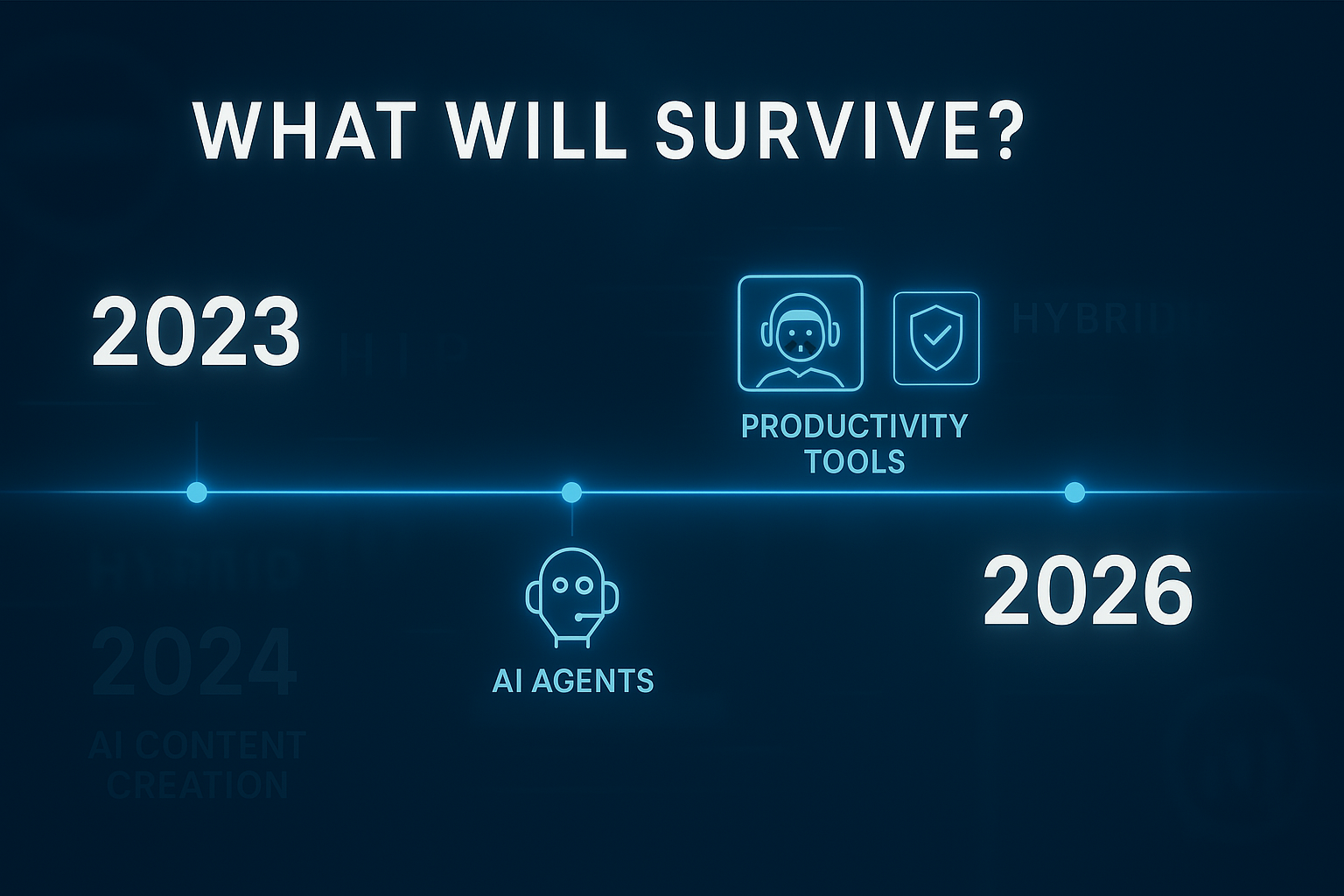From Hype to Habit: Which AI Tools Will Still Matter in 2026?

In the ever-accelerating world of artificial intelligence, distinguishing between transformative technologies and passing fads has become a critical skill for business leaders. As we move deeper into 2025, the AI landscape continues its dramatic evolution, leaving many wondering which tools deserve long-term investment and which might soon fade into obscurity.
The Great AI Reckoning
The past three years have witnessed an unprecedented explosion in AI tool development. From the moment ChatGPT captured global attention in late 2022, we've been inundated with new launches promising to revolutionize everything from content creation to customer service. Yet as AI fatigue sets in across industries, both consumers and business leaders are asking the same question: Which of these technologies will actually matter in a year's time?
"We're now entering the 'plateau of productivity' phase for many AI technologies," explains Dr. Maya Chen, Chief Innovation Officer at Toronto-based Maple AI Ventures. "The initial excitement has cooled, and organizations are making more calculated decisions about which AI tools deliver genuine business value versus those that simply generated buzz."
AI Assistants: Evolution, Not Revolution
Among the most visible AI tools are the large language model (LLM) assistants that burst onto the scene in 2022-2023. While many predicted these would completely transform how we work, the reality has been more nuanced.
"The assistants that will thrive through 2026 are those that have successfully integrated into existing workflows rather than demanding users completely change how they operate," notes William Garcia, technology analyst at Deloitte Digital. "We're seeing a clear divide between general-purpose assistants struggling to prove their ROI and specialized assistants delivering measurable value in specific domains."
Likely to Endure:
- Domain-specialized assistants: AI tools focused on specific industries or functions (legal, healthcare, customer service) with deep expertise rather than broad capabilities
- Assistants with enterprise guardrails: Solutions that prioritize data privacy, compliance, and robust security features
- Integrated workflow assistants: Tools that seamlessly connect with existing business systems rather than operating in isolation
Likely to Fade:
- Jack-of-all-trades assistants: Generic tools that promise to do everything but excel at nothing
- Consumer-grade assistants in enterprise: Solutions that lack the governance features needed for business environments
- Subscription-heavy business models: Tools charging premium prices without delivering clear, measurable ROI
AI Content Creation: Quality Over Quantity
The initial wave of AI content tools unleashed a flood of mediocre material across the internet. However, as search engines and audiences have become more discerning, the future belongs to more sophisticated approaches.
"The companies succeeding with AI content in 2025 are those using it as an enhancement to human creativity, not a replacement," says Emily Zhao, Content Strategy Director at Vancouver-based Northstar Digital. "We're seeing diminishing returns for organizations that tried to completely automate their content production."
Likely to Endure:
- AI-human collaborative tools: Platforms designed to augment rather than replace human writers and designers
- Multimodal creation suites: Solutions integrating text, image, video, and audio generation in coherent workflows
- Brand-voice customized AI: Tools that can be extensively trained on company voice and style guidelines
Likely to Fade:
- Basic text generators: Simple tools producing generic, templated content
- Stock AI image generators: As the market saturates with similar-looking AI art, distinctive visual styles will become more valuable
- One-size-fits-all video creators: Cookie-cutter video tools that produce content instantly recognizable as AI-generated
AI Agents: The Next Frontier
Perhaps the most significant development has been the rise of AI agents—autonomous systems that can perform complex tasks with minimal human supervision. While still evolving, these represent the leading edge of business AI adoption.
"Agents are where we're seeing the most transformative potential," explains Jordan Patel, Principal Researcher at Microsoft's AI labs. "The ability to delegate entire processes to AI systems that can reason, plan, and adapt has fundamentally changed how organizations think about automation."
Likely to Endure:
- Function-specific agents: Systems designed for particular business processes like customer support, scheduling, or research
- Agentic workflow orchestrators: Tools that coordinate multiple steps across different systems and departments
- Human-in-the-loop agents: Solutions that know when to escalate to human operators for complex decisions
Likely to Fade:
- "Do everything" agents: Overly ambitious systems promising to handle unlimited tasks without specialization
- Agents without clear metrics: Solutions that can't demonstrate concrete improvements to efficiency or outcomes
- Black box decision-makers: Systems that can't explain their reasoning or provide audit trails for their actions
Productivity and Development Tools: Integration Is Key
AI-enhanced productivity tools have flooded the market, yet only those delivering genuine efficiency gains while integrating seamlessly with existing systems will survive the inevitable consolidation.
"The winners in this space aren't creating more work for users," notes Samantha Williams, Principal at Boston Consulting Group. "They're reducing cognitive load, eliminating repetitive tasks, and fitting into established workflows without requiring teams to learn entirely new systems."
Likely to Endure:
- Code assistance tools: AI systems enhancing developer productivity through suggestions, automation, and error detection
- Meeting and communication enhancers: Solutions that improve collaboration through automated notes, action items, and follow-ups
- Data analysis accelerators: Tools that help non-technical users explore and derive insights from complex datasets
Likely to Fade:
- Isolated point solutions: Tools that don't connect to broader organizational systems and create data silos
- Overengineered interfaces: AI products that require extensive training before delivering value
- "AI-washing" features: Capabilities marketed as AI but delivering little genuine intelligence or automation
Privacy and Responsible AI: Non-Negotiable Features
As regulations like Canada's Consumer Privacy Protection Act and various US state laws take effect, solutions prioritizing data protection and responsible AI principles are becoming business necessities rather than nice-to-haves.
"Privacy-preserving AI isn't just a compliance issue—it's becoming a competitive advantage," says Nicole Thompson, Partner at McCarthy Tétrault's Technology Law Group. "Organizations that invest in responsible AI frameworks now will avoid costly retrofitting later."
Likely to Endure:
- On-premises and hybrid deployment options: Solutions offering secure local processing for sensitive data
- Explainable AI tools: Systems that provide transparency into their decision-making processes
- Bias detection and mitigation frameworks: Tools helping organizations identify and address algorithmic bias
Likely to Fade:
- Data-hungry algorithms: Models requiring excessive data sharing without clear privacy controls
- Black box decision systems: Solutions that can't explain how they reach conclusions
- Ethics as afterthought: Tools developed without considering potential misuse or harmful impacts
Building an AI Stack That Lasts
For organizations looking to invest in AI technologies that will remain relevant through 2026 and beyond, certain principles have emerged as essential:
For Business Leaders:
- Prioritize integration capabilities: Select tools that connect seamlessly with your existing technology ecosystem
- Measure concrete outcomes: Focus on solutions with demonstrable ROI rather than abstract promises
- Start with specific use cases: Target clearly defined problems rather than broad transformation initiatives
- Invest in AI literacy: Develop internal capabilities to evaluate and implement AI effectively
- Build governance frameworks: Establish clear policies for responsible AI use before widespread deployment
For Consumers:
- Value your attention: Choose tools that save time rather than becoming additional productivity drains
- Consider privacy implications: Understand how your data is being used and stored
- Look for learning curves: Tools that require substantial time investment should deliver proportional benefits
- Beware subscription traps: Evaluate whether ongoing costs are justified by continuous value
- Seek interoperability: Favor solutions that work with your existing digital tools
Overcoming AI Fatigue
The sheer volume of AI announcements has led to what industry observers call "AI fatigue"—a growing skepticism toward exaggerated claims and constant product launches.
"We're seeing a pendulum swing from irrational exuberance to equally irrational disillusionment," observes Michael Chang, Chief AI Officer at RBC. "The reality lies somewhere in between—AI is transformative for specific applications but isn't magic. Organizations need to cut through the noise and focus on concrete use cases."
To combat AI fatigue within organizations:
- Start small and demonstrate wins: Build confidence through targeted successes rather than ambitious moon shots
- Focus on user experience: Prioritize tools that reduce friction rather than adding complexity
- Develop clear evaluation frameworks: Create standardized approaches to assessing new AI capabilities
- Balance innovation with pragmatism: Continue exploring emerging technologies while focusing resources on proven solutions
The Road Ahead
As we look toward 2026, the AI landscape will likely see significant consolidation. Many standalone tools will either be acquired by larger platforms or fade away, while the truly valuable capabilities will become standard features in mainstream business applications.
"The most important AI might become invisible," suggests Rafael Martinez, Director of AI Strategy at IBM Canada. "Just as we no longer talk about 'mobile strategies' because mobile is simply how business operates, the most successful AI will become so integrated into workflows that we stop noticing it altogether."
For forward-thinking organizations, the challenge isn't predicting exactly which tools will dominate, but rather developing the institutional flexibility to adapt as the landscape evolves. Those that build strong foundations in AI literacy, responsible governance, and pragmatic implementation will be positioned to thrive regardless of which specific technologies emerge as leaders.
The AI tools that will still matter in 2026 won't be those generating the most headlines today, but those delivering consistent value within the complex realities of how organizations and individuals actually work. As we move beyond the hype cycle, the distinction between transformative technologies and passing fads becomes increasingly clear—and increasingly consequential for business success.
